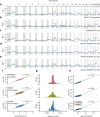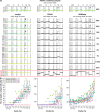Low-cost and clinically applicable copy number profiling using repeat DNA
- PMID: 35978291
- PMCID: PMC9386984
- DOI: 10.1186/s12864-022-08681-8
Low-cost and clinically applicable copy number profiling using repeat DNA
Abstract
Background: Somatic copy number alterations (SCNAs) are an important class of genomic alteration in cancer. They are frequently observed in cancer samples, with studies showing that, on average, SCNAs affect 34% of a cancer cell's genome. Furthermore, SCNAs have been shown to be major drivers of tumour development and have been associated with response to therapy and prognosis. Large-scale cancer genome studies suggest that tumours are driven by somatic copy number alterations (SCNAs) or single-nucleotide variants (SNVs). Despite the frequency of SCNAs and their clinical relevance, the use of genomics assays in the clinic is biased towards targeted gene panels, which identify SNVs but provide limited scope to detect SCNAs throughout the genome. There is a need for a comparably low-cost and simple method for high-resolution SCNA profiling.
Results: We present conliga, a fully probabilistic method that infers SCNA profiles from a low-cost, simple, and clinically-relevant assay (FAST-SeqS). When applied to 11 high-purity oesophageal adenocarcinoma samples, we obtain good agreement (Spearman's rank correlation coefficient, rs=0.94) between conliga's inferred SCNA profiles using FAST-SeqS data (approximately £14 per sample) and those inferred by ASCAT using high-coverage WGS (gold-standard). We find that conliga outperforms CNVkit (rs=0.89), also applied to FAST-SeqS data, and is comparable to QDNAseq (rs=0.96) applied to low-coverage WGS, which is approximately four-fold more expensive, more laborious and less clinically-relevant. By performing an in silico dilution series experiment, we find that conliga is particularly suited to detecting SCNAs in low tumour purity samples. At two million reads per sample, conliga is able to detect SCNAs in all nine samples at 3% tumour purity and as low as 0.5% purity in one sample. Crucially, we show that conliga's hidden state information can be used to decide when a sample is abnormal or normal, whereas CNVkit and QDNAseq cannot provide this critical information.
Conclusions: We show that conliga provides high-resolution SCNA profiles using a convenient, low-cost assay. We believe conliga makes FAST-SeqS a more clinically valuable assay as well as a useful research tool, enabling inexpensive and fast copy number profiling of pre-malignant and cancer samples.
Keywords: Barrett’s oesophagus; Bayesian nonparametrics; Cancer; Copy number profiling; FAST-SeqS; MCMC; Oesophageal adenocarcinoma; Probabilistic model; Somatic copy number alterations; Sticky HDP-HMM; Tumour purity.
© 2022. The Author(s).
Conflict of interest statement
RCF is named on patents related to Cytosponge and related assays that have been licensed to Covidien now Medtronic, and she is a shareholder in Cyted Ltd.
Figures


References
-
- Beroukhim R, Mermel CH, Porter D, Wei G, Raychaudhuri S, Donovan J, Barretina J, Boehm JS, Dobson J, Urashima M, Henry KTM, Pinchback RM, Ligon AH, Cho Y. -j., Haery L, Greulich H, Reich M, Winckler W, Lawrence MS, Weir BA, Tanaka KE, Chiang DY, Bass AJ, Loo A, Hoffman C, Prensner J, Liefeld T, Gao Q, Yecies D, Signoretti S, Maher E, Kaye FJ, Sasaki H, Tepper JE, Fletcher JA, Tsao M. -s., Demichelis F, Rubin MA, Janne PA, Tabernero J, Daly MJ, Nucera C, Levine RL, Ebert BL, Gabriel S, Rustgi AK, Antonescu CR, Ladanyi M, Letai A, Garraway LA, Loda M, Beer DG, True LD, Okamoto A, Pomeroy SL, Singer S, Golub TR, Lander ES, Getz G, Sellers WR, Meyerson M. The landscape of somatic copy-number alteration across human cancers. Nature. 2010;463(February):899–905. doi: 10.1038/nature08822. - DOI - PMC - PubMed
-
- Zack TI, Schumacher SE, Carter SL, Cherniack AD, Saksena G, Tabak B, Lawrence MS, Zhang C. -z., Wala J, Mermel CH, Sougnez C, Gabriel SB, Hernandez B, Shen H, Laird PW, Getz G. Pan-cancer patterns of somatic copy number alteration. Nat Genet. 2013;45(10):1134–40. doi: 10.1038/ng.2760. - DOI - PMC - PubMed
-
- Li Y, Roberts ND, Wala JA, Shapira O, Schumacher SE, Kumar K, Khurana E, Waszak S, Korbel JO, Haber JE, Imielinski M, PCAWG Structural Variation Working Group. Weischenfeldt J, Beroukhim R, Campbell PJ, PCAWG Consortium Patterns of somatic structural variation in human cancer genomes. Nature. 2020;578:112–21. doi: 10.1038/s41586-019-1913-9. - DOI - PMC - PubMed
MeSH terms
Substances
Grants and funding
LinkOut - more resources
Full Text Sources
Medical

